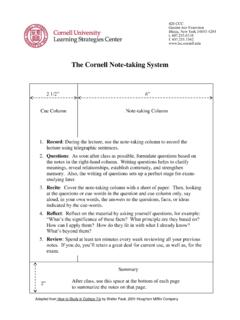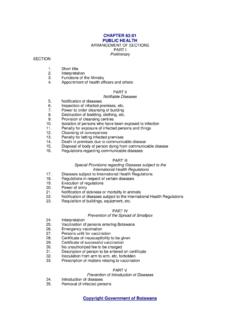Transcription of Topic #1: Introduction to measurement and statistics
1 Topic #1: Introduction to measurement and statistics " statistics can be fun or at least they don't need to be feared." Many folks have trouble believing this premise. Often, individuals walk into their first statistics class experiencing emotions ranging from slight anxiety to borderline panic. It is important to remember, however, that the basic mathematical concepts that are required to understand basic statistics are not prohibitive for any university. The key to doing well in any statistics course can be summarized by two words, "KEEP UP!
2 ". If you don't understand a concept - reread the material, do the practice questions at the end of each chapter, and don't be afraid to ask your instructor for clarification or help. This is important because the material discussed four weeks from today will be based on material discussed today. If you keep on top of the material and relax a little bit, you might even find you enjoy this Introduction to basic measurements and statistics . With that preface out of the way, we can now get down to the business of discussing, "What do the terms measurement and statistic mean?
3 " and "Why should we study measurement and statistics ?". What is a Statistic? statistics are part of our everyday life. All one needs to do is examine the baseball boxscores in the newspaper or their bank statement (hopefully, not in the newspaper) for examples of statistics . statistics in and of themselves are not anxiety producing. For example, most individuals (particularly those familiar with baseball) will not experience anxiety when a player's batting average is displayed on the television screen. The "batting average" is a statistic but as we know what it means and how to interpret it, we do not find it particularly frightening.
4 The idea of statistics is often anxiety provoking simply because it is a tool with which we are unfamiliar. Therefore, let us examine what is meant by the term statistic; Kuzma (1984) provides a formal definition: A body of techniques and procedures dealing with the collection, organization, analysis, interpretation, and presentation of information that can be stated numerically. Perhaps an example will clarify this definition. Say, for example, we wanted to know the level of job satisfaction nurses experience working on various units within a particular hospital (ie.)
5 Psychiatric, cardiac care, obstetrics, etc.). The first thing we would need to do is collect some data. We might have all the nurses on a particular day complete a job satisfaction questionnaire. We could ask such questions as "On a scale of 1 (not satisfied) to 10 (highly satisfied), how satisfied are you with your job?". We might examine employee turnover rates for each unit during the past year. We could also examine absentee records for a two month period of time as decreased job satisfaction is correlated with higher absenteeism.
6 Once we have collected the data, we would then organize it. In this case, we would organize it by nursing unit. Descriptive statistics are used to organize or summarize a particular set of measurements. In other words, a descriptive statistic will describe that set of measurements. For example, in our study above, the mean described the absenteeism rates of five nurses on each unit. The census represents another example of descriptive statistics . In this case, the information that is gathered concerning gender, race, income, etc.
7 Is compiled to describe the population of the United States at a given point in time. A baseball player's batting average is another example of a descriptive statistic. It describes the baseball player's past ability to hit a baseball at any point in time. What these three examples have in common is that they organize, summarize, and describe a set of measurements. Inferential statistics use data gathered from a sample to make inferences about the larger population from which the sample was drawn. For example, we could take the information gained from our nursing satisfaction study and make inferences to all hospital nurses.
8 We might infer that cardiac care nurses as a group are less satisfied with their jobs as indicated by absenteeism rates. Opinion polls and television ratings systems represent other uses of inferential statistics . For example, a limited number of people are polled during an election and then this information is used to describe voters as a whole. What is measurement ? Normally, when one hears the term measurement , they may think in terms of measuring the length of something (ie. the length of a piece of wood) or measuring a quantity of something (ie.)
9 A cup of flour). This represents a limited use of the term measurement . In statistics , the term measurement is used more broadly and is more appropriately termed scales of measurement . Scales of measurement refer to ways in which variables/numbers are defined and categorized. Each scale of measurement has certain properties which in turn determines the appropriateness for use of certain statistical analyses. The four scales of measurement are nominal, ordinal, interval, and ratio. Nominal: Categorical data and numbers that are simply used as identifiers or names represent a nominal scale of measurement .
10 Numbers on the back of a baseball jersey (St. Louis Cardinals 1 = Ozzie Smith) and your social security number are examples of nominal data. If I conduct a study and I'm including gender as a variable, I will code Female as 1 and Male as 2 or visa versa when I enter my data into the computer. Thus, I am using the numbers 1 and 2 to represent categories of data. Ordinal: An ordinal scale of measurement represents an ordered series of relationships or rank order. Individuals competing in a contest may be fortunate to achieve first, second, or third place.












